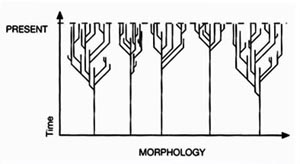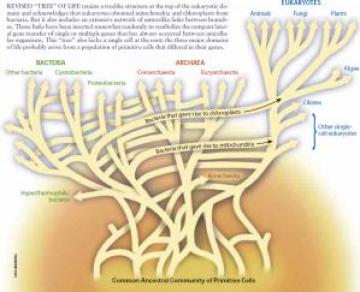Malcolm Gordon disbelieves universal common ancestry, and another scientist, Michael Behe, accepts it
Summary of problems:
The claim is being presented as if it indicates the presence of some deep problem within standard evolutionary theory. There is no such problem. The extent of monophyly is a technical issue within evolutionary theory on which there is continuing work and debate. That an intelligent design proponent may accept complete monophyly (although Behe's field of expertise lies elsewhere) while an evolutionary biologist may question it for the very early stages of life (in what he explicitly calls "A Speculative Essay" see Gordon [1999]) is irrelevant to the question whether descent with modification through natural mechanisms produced the organisms we see on Earth.
Full discussion:
Explore Evolution claims the scientific community has two fundamentally different views of common descent, the single tree of life (monophyletic) and the orchard of life (polyphyletic). This claim distorts the meaning of a polyphyletic group. Explore Evolution then implies that because there are evolutionists, such as Malcolm Gordon, who question the monophyletic origins of life and of tetrapods, they must also "disagree with universal common descent" and therefore support the orchard view of life.
From Explore Evolution:
Scientists who think that history of life is best represented by a single branching tree have what is called a monophyletic view ("mono" means one or single). Scientists who have a polyphyletic view ("poly" means many) think the history of life looks more like an orchard of separate trees.
As part of this tree discussion, we have to make an important distinction between the terms common descent and Universal Common Descent. You may think that these terms mean the same thing. They don t. As we've just seen, it's possible to think that some organisms share a common ancestor without thinking that all organisms are descended from a single common ancestor.EE, p10
 The Neocreationist orchard: "Figure:4 A polyphyletic (orchard) view: branching within major groups, but no connections between them." EE, p. 10.
The Neocreationist orchard: "Figure:4 A polyphyletic (orchard) view: branching within major groups, but no connections between them." EE, p. 10.
Explore Evolution is silent upon whether this orchard of life is composed of 3 trees or a 3 million trees, nor does Explore Evolution offer students any means by which they could make that distinction.
As discussed earlier in the critique of the Explore Evolution's Introduction, this view of polyphyletic trees is fully embraced by creationists. Indeed, there is a small group of Creation-scientists, baraminologists, who hope to find out how many trees, "created kinds" are in their orchard of life.
Taxonomy for baraminologists (biologists/paleontologists/zoologists who study the original created kinds) is one of detecting continuity and discontinuity. While the secular tree of life is essentially monophyletic (having one root), creationists view the tree of life as being polyphyletic (having multiple roots each root being a created kind, or "baramin"). Thus, we have continuity between created kinds and offspring, and discontinuity between separate created kinds.
This creationist view of polyphyletic group contrasts with its usage in evolutionary biology. According the textbook Evolution (2007) by Barton and colleagues.
It is frequently useful to refer to groups by how they relate to each other on a phylogenetic tree (Figs. 5.3 and 5.4). The simplest grouping is that of a monophyletic group, or clade, which consists of an ancestor and all of its descendants . In other situations, species are treated as a group because of some shared biological features, even though they do not share a common ancestor to the exclusion of other species. Such a collection of species is a polyphyletic group (derived from many (poly) ancestors; Fig. 5.3) Examples include gliding mammals (made up of species related to both fox and squirrels), gram-negative bacteria (see Fig. 6.2) and algae (see p. 198).Barton et al., (2007) Evolution, p. 111
Phylogenetic Trees: In each panel, the phylogenetic group is depicted by a green shaded circle. A) Monophyletic group. A species (C and D) share a common ancestor (E) not shared by any other species. (B) Paraphyletic group. All species in the group share a common ancestor (F), but some species (D) have been excluded from the group. (C) Polyphyletic group. A grouping of lineages each more closely related to other species not in the group than they are two each other.
From Barton et al., (2007) Evolution, p. 111.
To suggest that at least some mainstream evolutionary biologists accept the orchard view, Explore Evolution "quotes" Malcom Gordon, a paleontologist at UCLA who studies fish evolution.
Statement A
"The phenomenom of a monophyletic [single] origin of the universal tree of life probably did not occur. At the macro-scale life appears to have had many origins." Statement A was made by Malcolm Gordon, an evolutionary biologist at UCLA Would you have guessed that an evolutionary biologist would disagree with Universal Common Descent?EE, p. 142
Would you have guessed that Malcolm Gordon is being misrepresented by Explore Evolution?
The universal tree of life probably had many roots.M. Gordon et al., (1999) "The Concept of Monophyly: A Speculative Essay," Biology and Philosophy, p. 331
An example of such a tree is shown below.
 Modern tree of life: From W. Ford Doolittle (2000) "Uprooting the tree of life." Scientific American, 282(2):90-5. Note that distances are not necessarily to scale in this image. This image reflects a view held by some practicing scientists (including Dr. Doolittle, the author of the original article) that there was a period in life's early history when genes swapped so frequently that it is impossible to treat those earlier lineages as truly distinct, nor to trace those lineages back cleanly to a single ancestor. They do not dispute that life has some common ancestor, but they do seek to clarify how we talk about that ancestor.
Modern tree of life: From W. Ford Doolittle (2000) "Uprooting the tree of life." Scientific American, 282(2):90-5. Note that distances are not necessarily to scale in this image. This image reflects a view held by some practicing scientists (including Dr. Doolittle, the author of the original article) that there was a period in life's early history when genes swapped so frequently that it is impossible to treat those earlier lineages as truly distinct, nor to trace those lineages back cleanly to a single ancestor. They do not dispute that life has some common ancestor, but they do seek to clarify how we talk about that ancestor.
This view of the tree of life with a reticulated network of roots replaces the concept of the last universal common ancestor (LUCA) with the concept of a community of common ancestors who are related to one another via genetic exchanges. Although the reticulated tree of life began as a controversial idea, it is now fully embraced as a plausible evolutionary scenario.
As Barton and colleagues explain in their textbook Evolution (2007):
DNA can be passed from one evolutionary lineage to another, by a process known as lateral gene transfer. For our purposes, what is important is that lateral gene transfer creates chimeric organisms- organisms in which different parts of the genomes have different histories. It therefore follows that there cannot be single "Tree of Life". That is, a single tree cannot accurately represent the evolution of life. It may be better to represent species evolution as a reticulated network (eg. Fig 5.23B) with interconnecting branches.Barton et al., (2007) Evolution, p. 131-132
Scientists can be skeptical about a single universal common ancestor and accept universal common ancestry.

